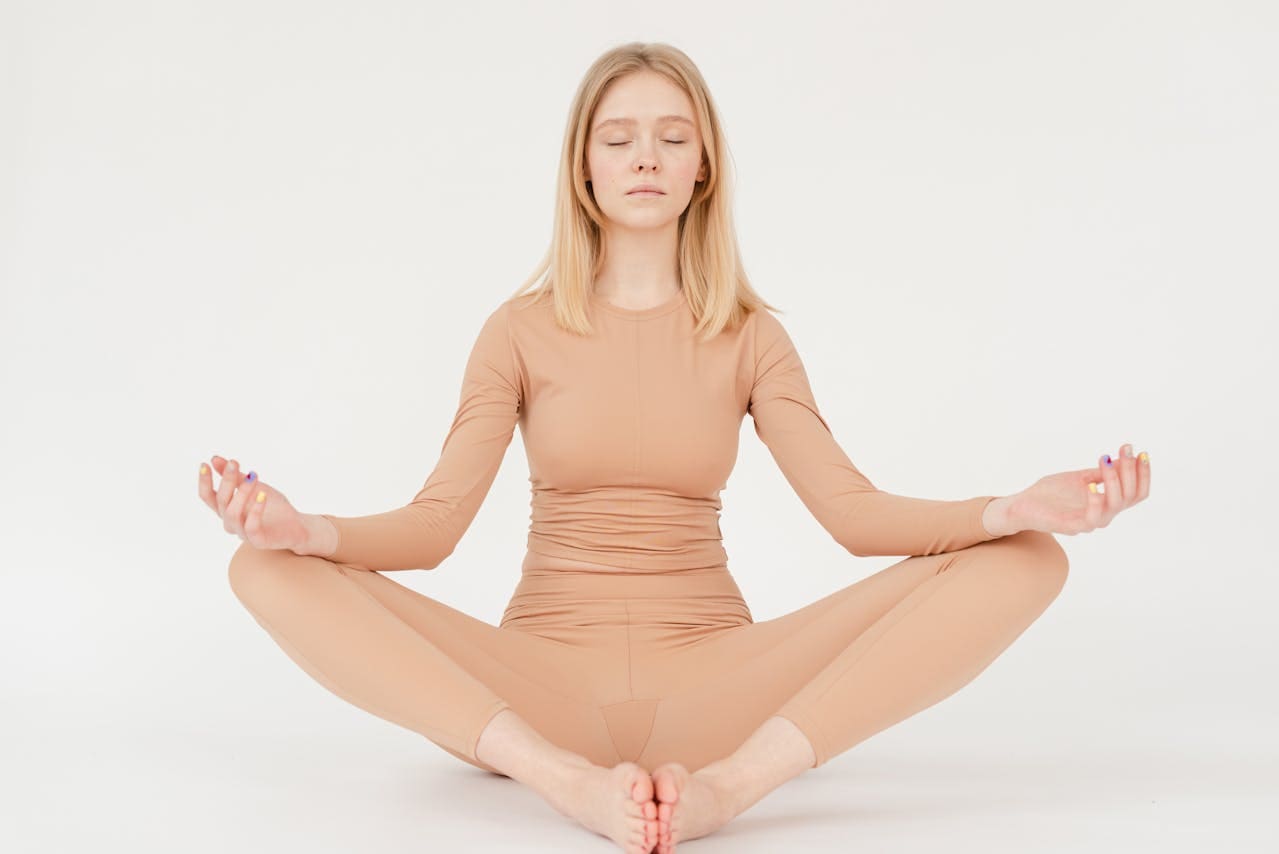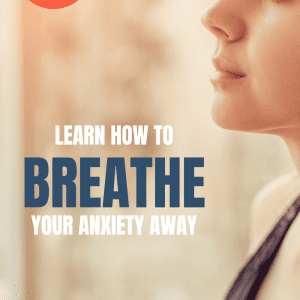Full Disclosure: Clicking on these links could mean a tiny commission for me, at no extra cost to you.
Your breath can be the most powerful tool for managing anxiety disorders, including acute and chronic anxiety, as it is closely linked to the nervous system. By incorporating these breathing exercises into your daily routine, you can significantly reduce anxiety levels and improve your overall mental health and wellbeing. This article explores ten effective breathing exercises for anxiety, explaining their benefits and how to perform them correctly, so you can start using a calming breath to soothe your nervous system.
What Are Breathing Techniques for Anxiety?
Breathing techniques for anxiety are controlled breathing exercises designed to manage stress and reduce anxiety symptoms. These techniques focus on slowing down the breath, engaging the diaphragm, and increasing oxygen flow to the brain, promoting a state of calm.
How Do Breathing Exercises Help Anxiety
It all comes down to science. When faced with stress or danger, the body’s natural reaction is the flight or fight response. This response triggers a series of physiological changes, including rapid breathing and increased heart rate. By controlling our breath, we can mitigate this response and induce a state of relaxation.
Deep breathing exercises also activates the parasympathetic nervous system, responsible for rest and digestion. This activation helps to counteract the effects of the sympathetic nervous system, which is responsible for the flight or fight response, thereby reducing anxiety levels.
Benefits of Breathing Techniques for Anxiety
One of the most significant benefits of breathing techniques is their ability to provide immediate relief from anxiety. Simple exercises can quickly lower heart rate and blood pressure, promoting a sense of calm. With regular practice, breathing techniques can also lead to long-term improvements in anxiety management.
- Reduces Stress and Anxiety: Techniques like diaphragmatic breathing and 4-7-8 breathing can quickly calm the nervous system, reducing immediate stress and anxiety levels 1
- Improves Focus and Concentration: Regular practice of breathwork, such as resonance breathing, can enhance mental clarity and focus
- Promotes Relaxation: Deep breathing exercises activate the parasympathetic nervous system, which helps the body relax and counteracts the fight or flight response 2
- Improves Sleep Quality: Mindful breathing and other exercises can reduce insomnia and improve sleep quality by promoting relaxation and reducing anxiety before bedtime 3
- Lowers Heart Rate and Blood Pressure: Slow, controlled breathing helps lower heart rate and blood pressure, contributing to overall cardiovascular health 4
- Enhances Emotional Regulation: Consistent practice of breathing exercises can help manage emotions better, reducing the frequency and intensity of anxiety episodes over time. It can also help reduce depression. 5
How to Practice Breathing Techniques Safely
Before starting any new breathing exercises, it’s important to understand the correct techniques to avoid hyperventilation or dizziness. After all, you want your breathing exercises to help your anxiety and not make your symptoms worse. So, always start slowly and increase the duration as you become more comfortable with the practice.
The most important thing is to practice these breathing exercises even when you aren’t anxious. This ensures you know how to do them properly when in need.
If you’re worried about forgetting your breathing techniques in the midst of an anxiety attack, jot the steps down in your phone’s notebook section, on a piece of paper or even on the back of your hand.
You can also follow expert-led breathwork classes online to perfect the practice, so that a calming breath is readily available to you when you need it.
Lastly, consider combining your breathing exercises with other anxiety practice to maximize the benefits. For example, you can use your fidget ring and spin the band with every breath. Next spin: take another breath. Next spin: take an exhale. Having a tangible item, like spinning anxiety jewelry, can also help release anxious energy in your body.
Ready to Transform Your Mental Health?
Inward Breathwork offers expert-led online classes designed to help you manage anxiety, reduce stress, and enhance your overall well-being.
Sign up today and enjoy a FREE month trial!
10 Powerful Breathing Techniques for Anxiety
If you’re struggling with anxiety, there are simple and effective breathing techniques you can use to alleviate symptoms and regain a sense of calm and control. These exercises can be practiced at any time of day and can be incorporated into longer relaxation sessions for added benefits.
1. Box Breathing
Box breathing helps to regulate the breath, reduce stress, and promote mental clarity. It’s particularly useful in high-stress situations and can be practiced anywhere. Bonus points if you visualize drawing a line of a box with each step.
- Sit in a comfortable position with your back straight.
- Inhale deeply through your nose for a count of four.
- Hold your breath for a count of four.
- Exhale slowly through your mouth for a count of four.
- Hold your breath again for a count of four.
- Repeat the cycle for 5-10 minutes.
2. Deep Diaphragmatic Breathing
Deep diaphragmatic breathing is a popular favourite breathing techniques for anxiety, especially when you’re experiencing panic. Diaphragmatic breathing helps to reduce stress, improve oxygen flow, and promote relaxation. It’s an effective technique for calming the mind and reducing anxiety symptoms.
- Sit or lie down in a comfortable position.
- Place one hand on your chest and the other on your abdomen.
- Inhale deeply through your nose, allowing your abdomen to rise while keeping your chest still.
- Exhale slowly through your mouth.
- Repeat for 5-10 minutes.
3. Yoga Breathing Technique
Anyone who practices yoga regularly knows just how powerful the breath can be. This breathing technique is commonly used within several styles of yoga to help calm the mind, body and spirit and it can work wonders when you’re feeling anxious.
- Take a slow, deep breath in
- Pause
- Slowly let your breath out
- Pause
- Repeat
4. Calming Counts
Counting your inhales and exhales is a great way to calm down during a panic attack. This breathing technique can take a bit longer to do, as it’s for a count of ten but it can be an effective way to relax your mind and body from your head to your toes.
- Take a long, deep breath in
- Slowly exhale, imagining all your anxious thoughts blowing out with your breath
- Close your eyes and take ten natural, easy breaths count down from ten with each
- Breath in, breath out – 10
- Breath in, breath out – 9
- Notice any tension in your body and relax them
- Open your eyes and repeat
5. The 4-7-8 Breathing Technique
4-7-8 breathing is also called the relaxing breath technique, and it’s one of the easiest and most effective breathing exercises out there. This technique is excellent for quickly reducing anxiety and promoting relaxation. It’s a powerful method for managing stress and improving sleep quality.
- Sit or lie down in a comfortable position.
- Inhale quietly through your nose for a count of four.
- Hold your breath for a count of seven.
- Exhale completely through your mouth for a count of eight.
- Repeat the cycle four times.
6. Equal Breathing (Sama Vritti)
This is one breathing technique that’s great for calming the mind, body and spirit. Equal breathing promotes balance and calmness, making it an effective technique for managing anxiety and stress. It’s also one of the easiest breathing techniques to do.
- Sit or lie down comfortably.
- Inhale through your nose for a count of four.
- Exhale through your nose for a count of four.
- Ensure that your inhales and exhales are of equal length.
- Repeat for 5-10 minutes.
7. Resonate or Coherent Breathing
Resonant breathing helps to synchronize heart rate and respiratory rate, reducing stress and promoting a sense of well-being.
- Sit or lie down in a comfortable position.
- Inhale for a count of six.
- Exhale for a count of six.
- Ensure each breath is slow and steady.
- Continue the practice for 5-10 minutes.
Tap Into Anxiety Relief Right Now
→ Mindfulness Meditation: Gain access to over 2000 guided meditations, stress relief techniques, and personalized plans to help you stay calm and focused. Get Started
→ Breathwork: Receive guided breathwork sessions designed to reduce stress and enhance your well-being. Get Started
8. Humming Bee Breath (Bhramari)
This technique helps to calm the mind, reduce stress, and improve concentration.
- Sit comfortably with your eyes closed.
- Inhale deeply through your nose.
- Exhale while making a humming sound like a bee.
- Focus on the vibration of the sound.
- Repeat for 5-10 minutes.
9. Alternate Nostril Breathing
Alternate nostril breathing is exactly what it sounds like and it can help calm your mind, body and spirit in a jiffy. This technique balances the left and right hemispheres of the brain, reduces stress, and enhances overall mental clarity.
- Sit in a comfortable position.
- Use your right thumb to close your right nostril.
- Inhale deeply through your left nostril.
- Close your left nostril with your right ring finger and release your right nostril.
- Exhale through your right nostril.
- Inhale through your right nostril, then close it with your thumb and release your left nostril.
- Exhale through your left nostril.
- Continue alternating for 5-10 minutes.
10. Lion’s Breath
Lion’s Breath relieves tension, reduces stress, and promotes a sense of release and relaxation. It’s an excellent breathing exercise for children too.
- Sit in a comfortable position with your hands on your knees.
- Inhale deeply through your nose.
- Open your mouth wide, stick out your tongue, and exhale forcefully while making a “ha” sound.
- Repeat the cycle 3-5 times.
Breathing techniques for anxiety offer a simple, effective way to manage stress and promote relaxation. By incorporating these exercises into your daily routine, you can achieve both immediate and long-term benefits for your mental health. Start practicing today to experience the calming effects of these powerful techniques.
FAQ
- What are the best breathing techniques for anxiety?
The best techniques include diaphragmatic breathing, box breathing, 4-7-8 breathing, and alternate nostril breathing. These methods are effective in calming the mind and reducing anxiety symptoms. - How often should I practice breathing exercises for anxiety?
Daily practice is recommended for the best results. Even a few minutes each day can significantly reduce anxiety levels and promote relaxation. - Can breathing techniques replace medication for anxiety?
Breathing techniques are a valuable tool in managing anxiety, but they should not replace medication without consulting a healthcare professional. They work best as part of a comprehensive treatment plan. - How long does it take to see results from breathwork?
Results can vary, but many people experience immediate relief from anxiety. Long-term benefits are typically seen with regular practice over weeks or months. - Are there any risks associated with breathing techniques?
When practiced correctly, breathing techniques are generally safe. However, it’s essential to avoid hyperventilation and ensure proper technique to prevent dizziness or discomfort. - Can children benefit from breathing activities for anxiety?
Yes, children can benefit from breathing activities. Techniques like diaphragmatic breathing and humming bee breath are simple and effective for managing anxiety in children.
Additional Resources
Ready to elevate your mental wellness? To help our readers thrive along their mental health journey, Anxiety Gone partners with leading experts in mental health and wellness field. Anxiety Gone may receive commission from the companies listed below at no extra cost to you.
Talk Therapy
Better Help offers access to over 20,000 licensed therapists available, starting at just $65 per week. Take a free online assessment today to get matched with the right therapist for you. Get Started
Virtual Psychiatry
Brightside Therapy offers anxiety and depression treatment online from licensed psychiatric providers and therapists. No need to wait, start a free consultation online today. Get Started
Mental Health Newsletter
Join our free Anxiety Gone newsletter and receive helpful tips and expert advice delivered right to your inbox. Sign Up
Mindfulness Plus+
Unlock over 2,000 mindfulness practices created by experts within the mindfulness and meditation field, with daily practices designed to meet your unique needs and aspirations, this serves as your daily companion toward a more mindful existence. Get Started
Digital Breathwork Classes
Reduce stress and anxiety from home with guided breathing exercises, created by leading experts and breath work gurus. Start Your Free Trial
Mental Health Support
Access our list of mental health support lines and crisis hotlines and receive immediate access to professionals trained to help. Find a Helpline
Infographics for Breathwork
References:- University of Michigan Health. Stress management: Breathing exercises for relaxation.
- Harvard Health Publishing. Harvard Medical School. Learning diaphragmatic breathing.
- Alaska Sleep Clinic. Simple sleep breathing exercises to help you relax.
- (( University of Michigan Health. Stress management: Breathing exercises for relaxation.
- Streeter CC, Gerberg PL, Whitfield TH, et al. Treatment of major depressive disorder with Iyengar yoga and coherent breathing: A randomized controlled dosing study. J Altern Complement Med. 2017; 23(6):236-243. doi:10.1089/acm.2016.0140.










